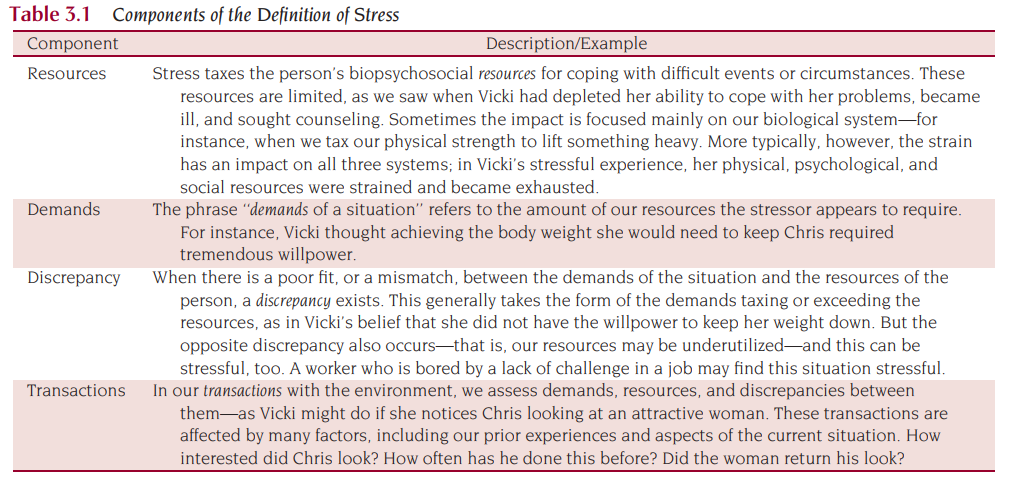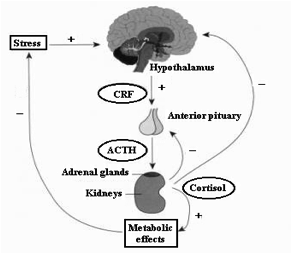Introduction of Stress
Some 75 per cent of diseases are said to be it related. For e.g., heart disease, hypertension, gastric ulcers, migraine, ulcerative colitis etc. People are spending lots of money to get tranquilizers prescription to relieve tension.
Definitions of Stress
Stress is a normal reaction the body has when changes occur. It is a feeling of emotional or physical tension.
It is the term used to describe the physical, emotional, cognitive, and behavioral responses to events that are appraised as threatening, demanding or challenging.
Stress as the circumstance in which transactions lead a person to perceive a discrepancy between the physical or psychological demands of a situation and the resources of his or her biological, psychological, or social systems (Lazarus & Folkman, 1984; Lovallo, 2005).
Some other important definitions of it include-
- Stress is the nonspecific response of the body to any demand placed upon it (Selye, 1936)
- Stress is a disruption in homeostasis that triggers a fight-or-flight response (Cannon, 1932)
- Stress is the physiological and psychological response to perceived environmental changes or threats, leading to an adaptive or maladaptive response (McEwen & Stellar, 1993)
- Stress is a reaction to life events that require adaptation, with a scale to measure the impact of various stressors (Holmes & Rahe, 1967)
Stress is a negative emotional experience accompanied by predictable biochemical, physiological, cognitive, and behavioral changes that are directed either toward altering the stressful event or accommodating to its effects.

Components of Stress
Nature of stress
Physical symptoms can include unusual fatigue, sleeping issues, frequent colds, even chest pains and nausea. People under it may behave differently, too like eating too much, crying a lot, smoking and drinking more than usual, or physically striking out at others by hitting or throwing things.
Emotional symptoms can include anxiety, depression, fear, and irritability, as well as anger and frustration.
Mental symptoms of stress include problems in concentration, memory, and decision making, and people under stress often lose their sense of humor.

Characteristics of Stressful Situations
Origin of Stress
- Any Stressor- presence or absence of any factor
- Life event – Loss of loved one, financial loss, etc
- Personality- life past experiences, beliefs, vulnerabilities, etc
Types of Stress
Stress can be divided into 2 broad types-
- Eustress – Hans Selye (1936) originally coined the term eustress to describe the stress experienced when positive events require the body to adapt. He define eustress as the optimal amount of stress that people need to promote for health and well-being.
- Distress – which occurs when people experience unpleasant stressors. its two types-
- Acute stress- This is short-term stress that goes away quickly. You feel it when you slam on the brakes, have a fight with your partner, or ski down a steep slope. It helps you manage dangerous situations. It also occurs when you do something new or exciting. All people have acute stress at one time or another.
- Chronic stress- This is stress that lasts for a longer period of time. You may have chronic stress if you have money problems, an unhappy marriage, or trouble at work. Any type of stress that goes on for weeks or months is chronic stress. You can become so used to chronic stress that you don’t realize it is a problem. If you don’t find ways to manage stress, it may lead to health problems
Lazarus’s Cognitive Appraisal Approach
Stress is the consequence of a person’s appraisal processes:
1. Primary appraisal occurs as a person is trying to understand what the event is and what it will mean. Events may be appraised for their harm, threat, or challenge.
- Harm is the assessment of the damage that has already been done, as for example being fired from a job.
- Threat is the assessment of possible future damage, as a person anticipates the problems that loss of income will create for him and his family.
- Challenge- the potential to overcome or even profit from the event.
2. Secondary appraisals- Assess whether personal resources are sufficient to meet the demands of the environment.

Cognitive Appraisal Approach
Types of stressor
- Emotional stressors
- Family stressors
- Social stressors
- Change stressors
- Chemical stressors
- Work stressors
- Decision stressors
- Commuting stressors
- Phobia stressors
- Physical stressors
- Disease stressors
- Pain stressors
- Environmental stressors
For example, a man who lost his job may regard his unemployment as an opportunity to try something new. Challenge assessments lead to more confident expectations that one can cope with the stressful event, more favorable emotional reactions to the event, and lower blood pressure, among other benefits (Blascovich, 2008).
According to American Psychological Association, (2008)- money, the economy, work, family health problems, and family responsibilities
are their top five stressors.
What Makes Event Stressful?
- Negative Events
- Uncontrollable Events
- Ambiguous Events
- Overload
Effect of Stress on Physiology
Some of the physiological effects of stress can be under
1. Sympathetic Activation
When an event has been appraised as stressful it triggers responses in the sympathetic nervous system.
- The stressful event produces catecholamines i.e. adrenalin and noradrenalin (epinephrine and norepinephrine) which cause changes blood pressure, heart rate, sweating and pupil dilation and is experienced as a feeling of arousal.
- This process is similar to the fight-or-flight (by Cannon, 1932). Catecholamines also have an effect on the body’s tissues and can lead to changes in immune function.
2. Hypothalamic-pituitary-adrenocortical (HPA) Activation
Stress triggers changes in the HPA system.
- This increases levels of cortisol, which results in more diffuse changes such as the management of carbohydrate stores and inflammation.
- These changes constitute the background effect of stress and cannot be detected by the individual.
- They are similar to the alarm, resistance and exhaustion stages of stress described by Selye (1956) in General Adaptation Syndrome.

HPA Axis
In addition, raised levels of endorphin and enkephalin have been found following stress which are involved in immune-related problems.
The physiological aspects of the stress response are linked to stress reactivity, stress recovery, the allostatic load and stress resistance.
Stress Reactivity
Changes in physiology are known as ‘stress reactivity’. Vary between individuals. Ex, some individuals respond to stressful events with high levels of sweating, raised blood pressure and heart rate while others show only a minimal response.
It will depend upon Primary and Secondary appraisal. Some people are simply more reactive to stress. Two people may show similar psychological reactions to stress but different physiological reactions. Some evidence for gender differences in stress reactivity(women showing smaller increases in blood pressure during stressful tasks, (Stoney et al. 1990). Stress reactivity is thought to be dispositional. may either be genetic or a result of prenatal or childhood experiences.
Stress recovery
After reacting to stress, the body then recovers and levels of sympathetic and HPA activation return to baseline. However, there is huge variability in the rate of recovery both between individuals and within individual across the lifespan. Chafin et al. (2004) reported that classical music improved recovery in the laboratory after a three-minute stressful challenge involving a mental arithmetic task.
Allostatic load
Stress recovery is linked with allostatic load which was described by McEwan and Stellar (1993). The concept of allostatic load refer to the physiological costs of chronic exposure to the physiological changes that result from repeated or chronic stress (McEwen, 1998). It is “the wear and tear on the body” which accumulates as an individual is exposed to repeated or chronic stress. They argued that the body’s physiological systems constantly fluctuate as the individual responds and recovers from stress – a state of allostatic – and that, as time progresses, recovery is less and less complete and the body is left increasingly depleted.
Indicators of Allostatic Load by Seeman, Singer, Horwitz, & McEwen, 1997
- Decreases in cell-mediated immunity
- The inability to shut off cortisol in response to stress
- Lowered heart rate variability
- Elevated epinephrine levels
- A high waist-to-hip ratio (reflecting abdominal fat)
- Hippocampal volume (which can decrease with repeat d stimulation of the HPA)
- Problems with memory (an indirect measure of hippocampal functioning)
- High plasma fibrinogen
- Elevated blood pressure
Stress resistance
To reflect the observation that not all individuals react to stressors in the same way, researchers developed the concept of stress resistance to emphasize how some people remain healthy even when stressors occur (e.g. Holahan and Moos 1990). Stress resistance includes adaptive coping strategies, certain personality characteristics and social support.
Read More- Response to Stress
References for stress
Ogden, J. (2017). Health psychology: A textbook (4th ed.).McGraw Hill Education.
Taylor, Shelley E. (2018). Health Psychology (10th ed). McGraw Hill Higher Education. Indian Edition
https://medlineplus.gov/ency/article/003211.html
https://www.mentalhealth.org.uk/a-to-z/s/stress
https://www.ncbi.nlm.nih.gov/pmc/articles/PMC2568977/
Subscribe to Careershodh
Get the latest updates and insights.
Join 18,526 other subscribers!
Niwlikar, B. A. (2021, December 8). What is Stress- Discover its 4 Important Definitions, Nature & 2 Types. Careershodh. https://www.careershodh.com/what-is-stress-its-definitions-nature-types/

Thank-you sir.